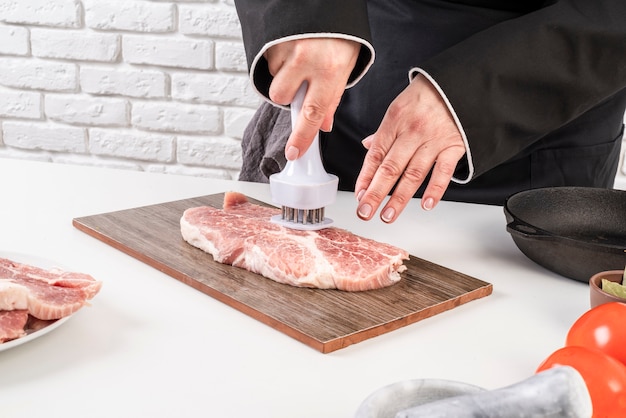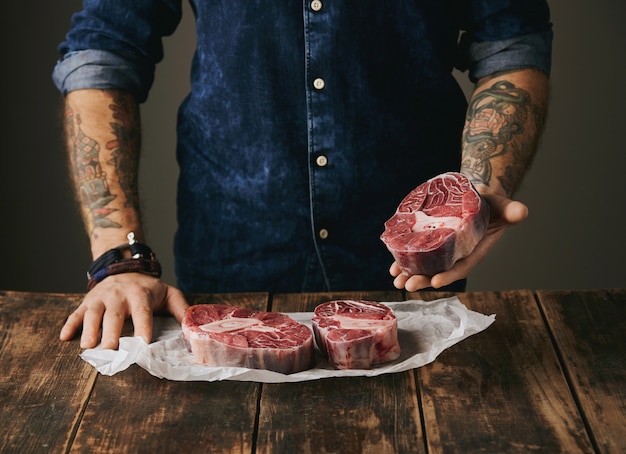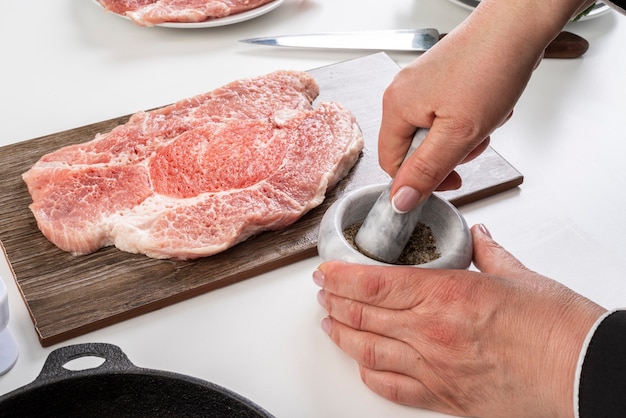We’ve all been there. Dinner plans are set, a juicy steak is the star of the show, but you realize, with a sinking feeling, that you completely forgot to thaw it. Panic sets in – a tough, chewy disaster flashes before your eyes. But wait! Don't throw in the towel just yet. cooking steak from frozen is entirely possible, and I’m here to guide you through the process.
I’m a huge steak fan – the smoky aroma, the perfectly seared crust, and that melt-in-your-mouth tenderness. Over the years, I’ve also had my fair share of frozen-steak mishaps. I’ve learned that while a thawed steak cooks more evenly and with a better texture, you can still get a delicious, juicy result from frozen. It just takes a little knowledge, patience, and a few helpful tips.
This article is your comprehensive guide to cooking steak from frozen. We’ll delve into the best cuts, explore the science behind cooking frozen meat, and master the techniques for pan-frying, grilling, and oven-roasting. So, grab your favourite skillet, fire up the grill, or preheat the oven, and let’s cook!
Part 1: Understanding the Science

The idea of cooking steak from frozen might seem a bit daunting, and many believe it’s a culinary crime. Let’s clear the air – it’s not a culinary crime, but it does pose a few challenges. The ice crystals in frozen meat act like tiny heat barriers, preventing even heat distribution. This can lead to uneven cooking and a tougher, less tender texture. But, it’s not a lost cause – with the right techniques, you can overcome these obstacles.
Why Cooking From Frozen Can Work
The key to cooking frozen steak is patience and a lower cooking temperature. The slow, gentle heat allows the ice to melt gradually, ensuring the meat cooks evenly. Imagine it like a slow-cooking process for your steak, where the heat is allowed to penetrate slowly.
While a thawed steak cooks more consistently, frozen steak can still be delicious. Think of it as a different approach, like a slow-cooked roast that takes longer to cook but yields incredibly tender results.
Why It's Generally Not Ideal
Now, it’s not ideal to cook steak from frozen if you have the time to thaw it. Here’s why:
- Tenderness: The trapped water in the ice crystals can make the meat slightly drier, affecting its tenderness. While not a complete deal-breaker, it won’t be as juicy as a thawed steak.
- Appearance: Uneven cooking can lead to some parts of the steak being overcooked while others remain raw, creating an unattractive appearance.
- Control: It’s harder to gauge the doneness of a frozen steak, requiring extra attention and a meat thermometer to ensure it’s cooked to your preference.
So, while it's not the ideal way, it’s not a culinary disaster either. You can definitely enjoy a delicious steak even if it's frozen, as long as you follow the right techniques.
Part 2: choosing the right cut

Not all steak cuts are created equal when cooked from frozen. Some cuts are better suited to handle the longer cooking times and uneven heat distribution.
Cuts That Work Best
Here are the cuts that tend to be more forgiving and hold their tenderness better:
- Ribeye: This classic cut, with its rich marbling and buttery flavour, is a champion for cooking from frozen. The thick cut withstands longer cooking times without becoming tough.
- new york strip: Another excellent choice, the New York strip is leaner than ribeye but has enough marbling to stay juicy. Its wide, flat shape allows for more even cooking and a beautiful crust.
- Porterhouse: This cut features a T-bone with a strip steak on one side and a tenderloin on the other. It's a hearty and flavorful choice, best for grilling as it can handle the longer cook time.
- Top Sirloin: Leaner than the others, but still a good option if you prefer a leaner steak. It's best for pan-frying or grilling, as it can be prone to dryness.
Cuts to Avoid
While you can technically cook any cut from frozen, these are better left thawed:
- Thin Cuts: Thin cuts like flank steak or skirt steak are more susceptible to drying out. Their delicate texture struggles with the extended cooking times.
- Tenderloin: Tenderloin, a lean cut, can become tough and dry if cooked from frozen. It's best to thaw it before cooking to ensure tenderness and juiciness.
Part 3: Preparing for Success

Now that you’ve chosen your cut, let's get ready to cook. Preparation is key for achieving a delicious frozen steak.
Seasoning Your Steak
Seasoning is vital for unlocking the flavour potential of your steak. Always use salt and pepper liberally, and feel free to add other spices like garlic powder, onion powder, paprika, or herbs like rosemary.
Here's a tip: Season the steak at least 30 minutes before cooking. This allows the salt to draw out moisture, helping to create a flavourful crust. If you’re short on time, you can season right before cooking, but the flavour won't be as intense.
Choosing Your Cooking Method
Your cooking method will depend on your preferences and available equipment.
- Pan-frying: This is a quick and easy method, perfect for a weeknight meal. It yields a beautifully browned steak with a tender interior.
- Grilling: Grilling is another great choice for frozen steak, especially thicker cuts. The smoky flavour and char enhance the taste.
- Oven-roasting: This slower method results in a tender and juicy steak. It's a great option for those who want to avoid overcooking or have more time to spare.
Whichever method you choose, make sure your cooking surface is preheated. For pan-frying, heat a heavy-bottomed skillet over medium-high heat. For grilling, preheat your grill to medium heat. And for oven-roasting, preheat your oven to 350°F (175°C).
Part 4: Cooking the Steak - Pan-Frying
Pan-frying is a popular method for cooking frozen steak, delivering a delicious, crispy crust and a tender interior. Here’s a step-by-step guide:
Step-by-Step Instructions
1. Heat Your Pan: Heat a heavy-bottomed skillet over medium-high heat. The pan needs to be hot enough to create a nice sear.
2. Add Oil: Add a tablespoon or two of oil to the pan. I prefer high-heat oils like avocado oil or grapeseed oil.
3. Sear the Steak: Carefully place the frozen steak in the hot pan. Don't overcrowd the pan; cook in batches if needed. Let the steak sear for 4-5 minutes per side, or until it develops a beautiful crust.
4. Reduce Heat and Continue Cooking: Reduce the heat to medium-low and continue cooking for another 5-7 minutes per side, or until it reaches your desired doneness.
5. Rest: Remove the steak from the pan and let it rest for 5-10 minutes before slicing and serving. This allows the juices to redistribute for a juicier and more tender result.
Tips and Tricks
- Don't Move It Around: Resist the urge to move the steak during searing. Let it sit undisturbed for at least 3 minutes per side to develop a beautiful crust.
- Use a Thermometer: A meat thermometer is essential for accurate cooking. Use a digital thermometer to check the internal temperature. The recommended internal temperature for medium-rare is 130°F (54°C), for medium is 140°F (60°C), and for medium-well is 150°F (65°C).
- Use a cast iron skillet: A cast iron skillet is ideal for pan-frying frozen steak. It retains heat well for even cooking.
- Add Butter: For extra flavour and richness, add a knob of butter to the pan during the last minute of cooking. This will baste the steak and give it a delicious buttery flavour.
Part 5: Cooking the Steak - Grilling
Grilling is a delicious way to cook frozen steak, adding smoky flavour and a crispy crust. Here's how to grill your frozen steak to perfection:
Step-by-Step Instructions
1. Preheat Your Grill: Preheat your gas or charcoal grill to medium heat. The grates need to be hot enough to create good sear marks.
2. Clean the Grates: Before placing the steak on the grill, make sure the grates are clean and oiled to prevent sticking.
3. Grill the Steak: Carefully place the frozen steak on the grill. Close the lid and let the steak cook for about 5-7 minutes per side, or until it reaches your desired doneness.
4. Flip the Steak: Flip the steak to cook the other side. Continue grilling for another 5-7 minutes, or until it reaches the desired internal temperature.
5. Rest: Remove the steak from the grill and let it rest for 5-10 minutes before slicing and serving.
Tips and Tricks
- Use a Thermometer: Always use a meat thermometer to check the internal temperature of the steak. This will ensure it's cooked to your liking.
- Don't Overcrowd the Grill: Don't overcrowd the grill. If you're cooking multiple steaks, cook them in batches to ensure they cook evenly.
- Don't Move it Around: Resist the urge to move the steak around too much while it's grilling. Let it sit undisturbed for at least 3 minutes per side to develop nice grill marks.
- Keep the Lid Closed: Keep the lid closed as much as possible while grilling. This will help trap the heat and ensure even cooking.
Part 6: Cooking the Steak - Oven-Roasting
Oven-roasting is the slowest method for cooking frozen steak, but it yields a tender and juicy result. Here’s how to achieve perfection:
Step-by-Step Instructions
1. Preheat Your Oven: Preheat your oven to 350°F (175°C).
2. Place the Steak in a roasting pan: Place the frozen steak in a roasting pan. If you're using a smaller roasting pan, you might need to cook the steak in batches.
3. Add Liquid: Pour a cup of beef broth or water into the roasting pan. This will help keep the steak moist and prevent it from drying out.
4. Roast the Steak: Roast the steak for about 45-60 minutes, or until it reaches your desired level of doneness.
5. Rest: Remove the steak from the oven and let it rest for 10-15 minutes before slicing and serving.
Tips and Tricks
- Use a Thermometer: Use a meat thermometer to check the internal temperature of the steak.
- Baste the Steak: For extra flavour and moisture, baste the steak with pan juices every 15-20 minutes while it's roasting.
- Add Vegetables: For a complete meal, add vegetables to the roasting pan along with the steak.
Part 7: Cooking Times and Internal Temperatures
Knowing how long to cook your frozen steak and what temperature to aim for is crucial to achieving the perfect doneness.
Remember that cooking times for frozen steak are longer than for thawed steak. The thicker the cut, the longer it will take to cook.
Approximate Cooking Times (Pan-Frying and Grilling)
| Steak Thickness | Medium-Rare (130°F/54°C) | Medium (140°F/60°C) | Medium-Well (150°F/65°C) |
|---|---|---|---|
| 1-inch thick | 10-12 minutes | 12-14 minutes | 14-16 minutes |
| 1.5-inches thick | 15-18 minutes | 18-20 minutes | 20-22 minutes |
| 2-inches thick | 20-25 minutes | 25-30 minutes | 30-35 minutes |
Approximate Cooking Times (Oven-Roasting)
| Steak Thickness | Medium-Rare (130°F/54°C) | Medium (140°F/60°C) | Medium-Well (150°F/65°C) |
|---|---|---|---|
| 1-inch thick | 45-50 minutes | 50-55 minutes | 55-60 minutes |
| 1.5-inches thick | 60-65 minutes | 65-70 minutes | 70-75 minutes |
| 2-inches thick | 75-80 minutes | 80-85 minutes | 85-90 minutes |
These are just approximate cooking times. The actual cooking time will depend on factors such as the steak's thickness, your cooking method, and the temperature of your oven or grill.
Using a Meat Thermometer
The most reliable way to ensure your steak is cooked to your liking is to use a meat thermometer. Insert the thermometer into the thickest part of the steak, making sure it's not touching any bone.
Part 8: The Crucial Rest
Once your steak is cooked, resist the urge to slice and serve immediately. Letting it rest is essential for a tender, juicy steak.
Why Resting Matters
Heat causes the muscle fibers in steak to contract, squeezing out juices. This is why steak can sometimes seem dry after cooking. Resting allows the muscle fibers to relax, reabsorbing the juices for a juicier result.
Resting Time
Resting time depends on the thickness of the cut. A general rule is 5-10 minutes for thinner cuts and 10-15 minutes for thicker cuts.
Resting Techniques
Rest your steak on a cutting board, a plate, or, my favourite, on a wire rack placed over a baking sheet. This allows the juices to drain away from the steak, preventing it from becoming soggy.
Part 9: Serving and Savouring Your Steak
After your steak has rested, it's finally time to enjoy!
Slicing the Steak
Before slicing, use a sharp knife to cut off any excess fat or gristle. Then, slice the steak against the grain. This helps to make the steak more tender and easier to chew.
Serving Suggestions
There are endless possibilities for serving your steak. Here are a few ideas:
- With a Side of Mash: Classic and comforting, creamy mashed potatoes are a perfect pairing for a juicy steak.
- With Roasted Vegetables: Roasted vegetables add colour, texture, and flavour to your steak meal.
- With a Salad: A fresh salad adds a light and refreshing element to your meal.
- With a Sauce: A delicious sauce can enhance the flavour of your steak. Try a classic béarnaise sauce or a simple red wine sauce.
And there you have it! Cooking steak from frozen is entirely possible. With the right techniques, you can enjoy a delicious and juicy steak even if you forgot to thaw it. So next time you’re in a pinch, don’t panic. Follow my tips, and you'll be enjoying a delicious steak in no time.
FAQs
1. Can I Cook Frozen Steak in the slow cooker?
Yes, you can cook frozen steak in a slow cooker. It's best to cook it on low heat for a longer period, about 6-8 hours, to ensure even cooking. Add some liquid to the slow cooker, such as beef broth or water, to keep the steak moist.
2. How Do I Know When My Frozen Steak is Cooked?
The most reliable way to know when your frozen steak is cooked is to use a meat thermometer. Insert the thermometer into the thickest part of the steak, ensuring it's not touching any bone. The recommended internal temperature for medium-rare steak is 130°F (54°C), for medium is 140°F (60°C), and for medium-well is 150°F (65°C).
3. Can I Cook Frozen Steak in a pressure cooker?
Yes, you can cook frozen steak in a pressure cooker. Add enough liquid to the pressure cooker to prevent the steak from drying out. Cook the steak on high pressure for about 20-30 minutes, depending on the thickness of the cut.
4. What If My Frozen Steak is Partially Thawed?
If your frozen steak is partially thawed, you can still cook it. However, you'll need to adjust the cooking times accordingly. It will cook faster than a completely frozen steak, so be careful not to overcook it. Use a meat thermometer to check the internal temperature and adjust the cooking time as needed.
5. Is It Safe to Cook Steak From Frozen?
Yes, it's perfectly safe to cook steak from frozen. As long as you cook the steak to the proper internal temperature, it will be safe to eat. The USDA recommends cooking steak to an internal temperature of 145°F (63°C) for medium-rare, 160°F (71°C) for medium, and 170°F (77°C) for well-done.
Everyone is watching

Corn on the Cob: The Ultimate Guide to Perfectly Cooked Ears
Healthy MealsAh, corn on the cob. Just the name evokes images of sunny days, barbecues, and that sweet, juicy flavour that ...

Scallops: The Ultimate Guide to Perfect Cooking
Healthy MealsAh, scallops. Those delicate, sweet, and utterly delicious morsels of the sea. They hold a special place in my...

Spaghetti Squash: The Ultimate Guide to Cooking and Serving
Healthy MealsRemember that time you saw spaghetti squash at the supermarket, looking all bumpy and strange, and thought, "W...

Salmon Cooking Times: Perfect Guide for Every Recipe
Healthy MealsLet me tell you, cooking salmon is an art form. It's all about getting that perfect balance: juicy and tender,...

Ham Cooking Time: How Long to Bake, Smoke, or Boil a Delicious Ham
Healthy MealsAh, ham. It's a classic, isn't it? A real crowd-pleaser, especially around holidays. And when done right, it'...
